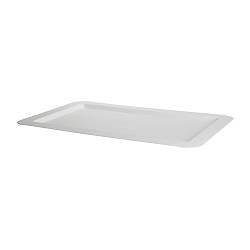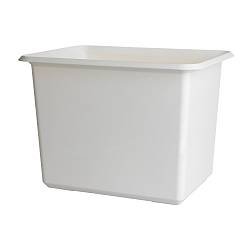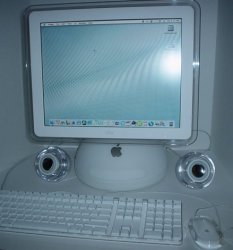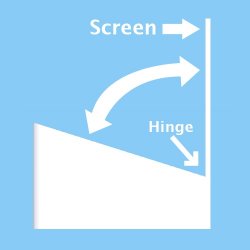And did Microsoft require you to labor non-stop with their screen? No.
No...because right now their experience doesn't cover serious applications, it's just messy photo moving/resizing, menu ordering, and finger painting. Not things people do for a living.
Plus laptop keyboards (such as my iBook's keyboard) are often flat and people (myself included) have no trouble using them at all....So how is this worse than doing paper work again? Now you get to select an angle--an added bonus if you ask me!
But you're not as hunched over when looking at your laptop screen are you? The simple fact is that your spine and neck want to be upright in a straight line and your arms and hands would love to be on or near your lap. If you combine the monitor and the input device on a large scale, one of these is going to be out of alignment and will fatigue quickly or suffer repetitive stress injuries.
That's why the mouse will still exist and will be used as a standard computer tool as an input device--the keyboard will also be used and obviously the multi-touch screen additionally. A standard desk or table will come with a mouse and a keyboard--the on screen keyboards have a long way to go before they can ever eliminate the need for a standard keyboard.
So why add it on a large scale (directly on the monitor) if it's not adding anything but cost, unnecessary complexity and possible ergonomic problems?
Touch screen interfaces won't have small buttons--resolution independent user interfaces has already solved this problem--buttons and windows will be scaled for use in a multi-touch screen environment.
But you said the keyboard and mouse aren't going away...so either these buttons will look bigger than those using keyboards and mice will need, or you will have to perform a "gesture" to rescale them...which takes away from the usefulness of such technology. Hmmm....I can click a tool with the mouse or using multitouch I can adjust the screen to make the tool a size that I can touch, select it, and then adjust the screen to go back where I was...hmmm...much easier just to use the mouse or a keyboard command.
Why overdevelop a horse and buggy when it will never be as good as an automobile anyway--it's time to move on the track pad will never be able to efficiently do what a multi-touch screen can do.
Yeah...you're arguing will yourself there since I was replying to your quote:
I have a multi-touch trackpad on my iBook G4--Apple is ahead of you on this one or else you are behind in technology.
It's time to move on--let's not be old fashioned it's time to use a flashlight instead of a candle. Imagine things better--don't imagine things in the context of the way that they are today--that's too limiting and holds us down when we're ready to fly.
Listen, I'm hardly a Luddite when it comes to new technology...but how exactly is a multi-touch Surface wannabe or a multi-touch monitor better on a large scale? You outlined the problems will the Surface in your first post. The main "gestures" of multi-touch on the Surface device are dragging, rotating, scaling, and selecting. If a small multi-touch surface was added to the keyboard, or added as another device at comfortable hand level while the visual monitor remained at comfortable eye level...you'd have all the functionality (and possibly more) of the Surface
plus you can keep the added precision that the using the cursor allows and you wouldn't have to worry about additional ergonomic problems.
"Local retail stores" is what Popular Mechanics stated on a video (linked here). Plus it specifically says on Microsoft's Surface web area that they "won't hit the market until winter 2007" implying that they will be released this winter.
It will be in local retail stores as a display interface. In restaurants using the menu app, I believe T-Mobile stores will be using them, you'll see them in hotels, fancy bars and clubs. At $5,000-$10,000 a piece, they are not being marketed to the average or even above average computer owner.
It isn't true that everything requires touch to be used (phones and PDA will be optionally the same as they are today) but yes as you mentioned the "domino" tags do need to touch the screen (or they probably at least need to be near the surface of the screen so that the computer cameras can see what the domino pattern is on the tags) but it is a new technology that is optional and hasn't been possible before.
My point is that physical or proximal contact is actually a liability to the Surface. If a "grab", "throw" and "catch" is built into the interface...you'll be able to "grab" photos from all devices (automatically with paired and on permission from unpaired) in a given range. (Imagine holding an anniversary party where everyone has cameras, opening iPhoto...clicking the Grab tool, selecting "All from All Available" from the pull down menu...and downloading all the photos on cameras and cameraphones within range to your MacBook.)
The problem I see is at the device level...devices need to be smart enough to turn on when communicated with but without sapping too much battery power. (For example, I want to be able to grab photos from my camera when it's still sitting downstairs in my camera bag...or if I take a picture, I'd love to be able to use my camera to "throw" it at my sleeping computer and have it wake up and catch it. This is the real area where the technology is lagging and needs to evolve.
Aren't you happy for something with new possibilities that can have some really good practical uses? For example you could take your favorite chess set pieces and print out domino tags (in the form of sticky labels) for each piece--all of the pawns would probably have the same pattern and the king would have a different pattern and the queen would have a different pattern too.
Now who's using the candle instead of the flashlight?...who needs a chess set when the computer has them built in?...this is actually where multi-touch would come in handy (and how you'll see Surface used in upscale bars and cafes)...the ability to play standard board games where you'll be able to manipulate the board in three dimensions. The main problem with Surface is that it hasn't evolved much since the demo (as the
playanywhere project) that I saw last year on youtube, they've figured out how to put the cameras inside a box and cover it to make it an actual product...but other than that it hasn't evolved much.
Multi-touch has applications...where we differ is the nature of these applications. As I stated above...I see a small-scale input devices being the logical next-step in the evolution of the technology. Multi-touch devices that can serve as mixing boards, color or brush palettes being applications that come to mind fastest. Not replacing the workspace on screen but amplifying it by enabling multiple inputs (instead of a graphic designer having to move to the color palette on the screen, they touch the color in their multi-touch palette with one finger without needing to move their cursor). On the other hand, some areas will retain the need for tactile feedback (The keyboard is one such area and I personally can't imagine trying to use a multi-touch jog-shuttle control...I'd need tactile feedback for that).










